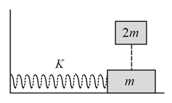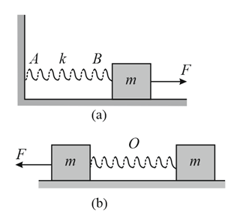The potential energy of a body of unit mass moving in one dimensional conservative force field is given by All units are in SI. For this situation mark out the correct statement(s).

Important Questions on Linear and Angular Simple Harmonic Motion
A horizontal plank has a rectangular block placed on it. The plank starts oscillating vertically and simple harmonically with an amplitude of 40 cm. The block just loses contact with the plank when the latter is at momentary rest. Then–
An object of mass is performing simple harmonic motion on a smooth horizontal surface as shown in the figure. Just as the oscillating object reaches its extreme position, another object of mass is dropped on to oscillating object, which sticks to it. For this situation mark out the correct statement(s).

The given Fig. (a) shows a spring of force constant fixed at one end and carrying a mass at the other end placed on a horizontal frictionless surface. The spring is stretched by a force Figure (b) shows the same spring with both ends free and a mass fixed at each free end. Each of the spring is stretched by the same force The mass in case (a) and the masses in case (b) are then released. Which of the following statements are true?

